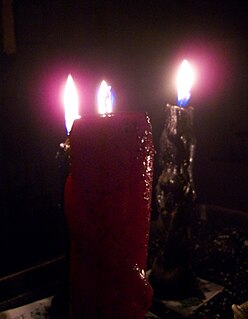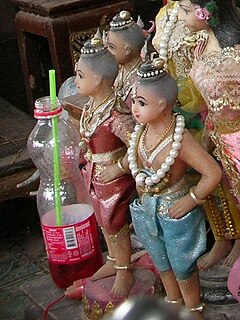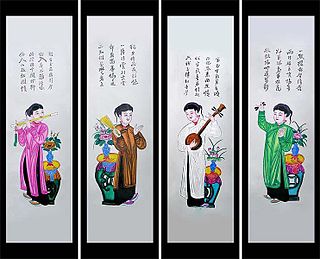 W
WAmir Kulāl (1278–1370), Persian: امیر کلال, Arabic: امیر کلال, birth name Shams ud-Dīn, was a Persian Sufi Islamic scholar, widely considered to be one of the most influential in history. He was a member of the mystical Khajagan order. His father was the Sufi scholar Saif ud-Dīn Hamza, a sayyid descendant of Prophet Muhammad. Saif ud-Dīn Hamza was amir (chieftain) of the Persian Kulal-Tribe, his full title being Amir-i-Kulal. After his father's death, Shams ud-Dīn became the amir and head of the tribe. By this time his reputation as a scholar and religious figure had spread through Chagatai Khanate and the title Amir-i-Kulal, had become his common name. Shams ud-Dīn was named after his grandfather, the spiritual mentor of the Barlas tribe and of Turghai, the father of Amir Timur. Because he made earthenware, he was popularly referred to as “Kulāl”, which means "potter" in Persian.
 W
WChinese folk religion, also known as Chinese popular religion, is a general term covering a range of traditional religious practices of Han Chinese, including the Chinese diaspora. Vivienne Wee described it as "an empty bowl, which can variously be filled with the contents of institutionalized religions such as Buddhism, Taoism, Confucianism, the Chinese syncretic religions." This includes the veneration of shen (spirits) and ancestors, exorcism of demonic forces, and a belief in the rational order of nature, balance in the universe and reality that can be influenced by human beings and their rulers, as well as spirits and gods. Worship is devoted to gods and immortals, who can be deities of places or natural phenomena, of human behaviour, or founders of family lineages. Stories of these gods are collected into the body of Chinese mythology. By the Song dynasty (960-1279), these practices had been blended with Buddhist doctrines and Taoist teachings to form the popular religious system which has lasted in many ways until the present day. The present day governments of both mainland China and Taiwan, like the imperial dynasties, tolerate popular religious organizations if they bolster social stability but suppress or persecute those that they fear would undermine it.
 W
WGavari, also spelt Gavri, is a 40-day long festival celebrated in July and September of each year in the Mewar region of Rajasthan, India.
 W
WHoodoo is a set of spiritual practices, traditions, and beliefs created by enslaved Africans in North America that were held in secret from slaveholders. Hoodoo evolved from various traditional African religions and practices, and in the American South, incorporated various elements of indigenous botanical knowledge. In the Gullah South Carolina Lowcountry, Hoodoo is also known as "Lowcountry Voodoo." Following the Great Migration of African-Americans, Hoodoo spread throughout the United States. Practitioners of Hoodoo are called rootworkers, conjure doctors, conjure man or conjure woman, and Hoodoo doctors. Regional synonyms for hoodoo include conjure or rootwork.
 W
WKaharingan is an animistic folk religion professed by many Dayaks in Kalimantan, Indonesia; particularly Central Kalimantan, although many have converted to Christianity or Islam or follow a syncretic religion. It is estimated that most Dayaks follow their ancient animistic religious traditions (Kaharingan), but often claim to belong to one of the recognized religions in Indonesia to prevent discrimination.
 W
WKuman Thong is a household divinity of Thai folk religion. It is believed to bring luck and fortune to the owner if properly revered. Kuman, or Kumara (Pali) means "Sanctified young boy" ; thong means golden.
 W
WCunning folk traditions, sometimes referred to as folk magic, were intertwined with the early culture and practice of the Latter Day Saint movement. These traditions were widespread in unorganized religion in the parts of Europe and America where the Latter Day Saint movement began in the 1820s and 1830s. Practices of the culture included folk healing, folk medicine, folk magic, and divination, remnants of which have been incorporated or rejected to varying degrees into the liturgy, culture, and practice of modern Latter Day Saints.
 W
WMaavalla Koda is a religious organisation uniting adherents of the two kinds of Estonian native religion or Estonian Neopaganism: Taaraism and Maausk.
 W
WNang Kwak is a spirit or household divinity of Thai folklore. She is deemed to bring good fortune, prosperity, attract customers to a business, and found among merchants.
 W
WNang Ta-khian is a female spirit of the folklore of Thailand. It manifests itself as a woman that haunts Hopea odorata trees. These are very large trees known as Ta-khian (ตะเคียน) in Thai, hence her name.
 W
WNang Tani is a female spirit of the Thai folklore. According to folk tradition, this ghost appears as a young woman that haunts wild banana trees, known as in Thai language as Kluai Tani (กล้วยตานี).
 W
WỌdịnala, also Ọdịnanị, Ọdịlalị or Ọdịlala, comprises the traditional religious practices and cultural beliefs of the Igbo people of southern Nigeria. Ọdịnanị has monotheistic and panentheistic attributes, having a single God as the source of all things. Although a pantheon of spirits exists⸺these being Ala, Amadiọha, Anyanwụ, Ekwensu, Ikenga, these are lesser spirits prevalent in Ọdịnanị expressly serving as elements of Chineke, the supreme being or high God. Chineke is a compound word encompassing the concept of chí is the creator (nà) is a verb meaning 'that' while ékè means create. Chineke therefore means the Creator or the God that created all things.
 W
WSakabashira or sakasabashira, meaning "reverse pillar," is a folk belief about wooden structures in Japan, and it refers to reversing the vertical direction of a tree from its original direction of growth when using it to make a pillar in a wooden building.
 W
WThe history of popular religion in Scotland includes all forms of the formal theology and structures of institutional religion, between the earliest times of human occupation of what is now Scotland and the present day. Very little is known about religion in Scotland before the arrival of Christianity. It is generally presumed to have resembled Celtic polytheism and there is evidence of the worship of spirits and wells. The Christianisation of Scotland was carried out by Irish-Scots missionaries, and to a lesser extent those from Rome and England, from the sixth century. Elements of paganism survived into the Christian era. Most early evidence of religious practice is heavily biased towards monastic life. Priests carried out baptisms, masses and burials, prayed for the dead and offered sermons. The church dictated in moral and legal matters and impinged on other elements of everyday life through its rules on fasting, diet, the slaughter of animals and rules on purity and ritual cleansing. One of the main features of Medieval Scotland was the Cult of Saints, with shrines devoted to local and national figures, including St Andrew, and the establishment of pilgrimage routes. Scots also played a major role in the Crusades. Historians have discerned a decline of monastic life in the late medieval period. In contrast, the burghs saw the flourishing of mendicant orders of friars in the later fifteenth century. As the doctrine of Purgatory gained importance the number of chapelries, priests and masses for the dead within parish churches grew rapidly. New "international" cults of devotion connected with Jesus and the Virgin Mary began to reach Scotland in the fifteenth century. Heresy, in the form of Lollardry, began to reach Scotland from England and Bohemia in the early fifteenth century, but did not achieve a significant following.
 W
WVietnamese folk religion or Vietnamese indigenous religion, is the ethnic religion of the Vietnamese people. About 45.3% of the population in Vietnam are associated with this religion.